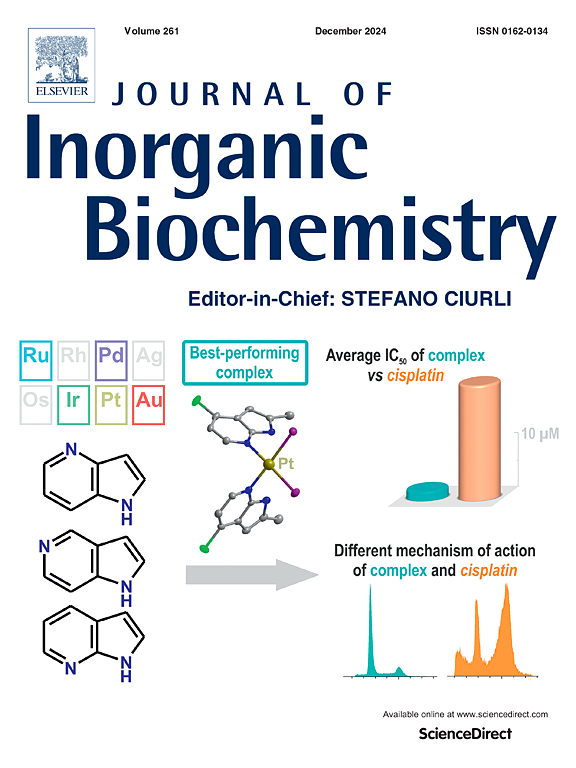An efficient circularly polarized luminescence probe base on anthryl-modified Eu(III)-helicates for the detection and imaging singlet oxygen in living cells
IF 3.8
2区 化学
Q2 BIOCHEMISTRY & MOLECULAR BIOLOGY
引用次数: 0
Abstract
Singlet oxygen (1O2) is the main active ingredient in photodynamic therapy (PDT). However, an excess 1O2 can cause unnecessary toxicity. Therefore, it is of great importance to develop reliable and sensitive methods or probes for detecting 1O2 in biological systems. In this study, a pair of anthryl-modified Eu(III) binaphthol-bis-β-diketones helicates, (NEt4)2[Eu2(LR/S)4] are designed, synthesized and characterized. Initially, the complexes display faint luminescence. Upon reacting with 1O2 to create endoperoxides of the anthracene framework, the long-lived luminescence of the Eu(III) complexes is activated. Notably, the high luminescence dissymmetry factor, glum of the 5D0 → 7F1 transition (595 nm) shows an obvious increase from −1.21 to −1.29 before and after oxidation. The complex exhibits a highly selective luminescent response to the 1O2 generated by 5-aminolevulinic acid (ALA) loaded 4 T1 cells during photodynamic processes. To the best of we knowledge, this is the first example of 1O2 detection based on circularly polarized luminescence (CPL) probe. The design of the lanthanide CPL probe provides a practical way for the sensitive detection of 1O2 in the future.

基于蒽基修饰Eu(III)-螺旋的高效圆偏振发光探针,用于检测和成像活细胞中的单线态氧
单线态氧(1O2)是光动力疗法(PDT)的主要活性成分。然而,过量的氧会引起不必要的毒性。因此,开发可靠、灵敏的检测生物系统中o2的方法或探针具有重要意义。本研究设计、合成并表征了一对蒽基修饰Eu(III)双萘酚-双β-二酮酯(NEt4)2[Eu2(LR/S)4]。最初,这些复合体发出微弱的光。当与1O2反应生成蒽骨架的内过氧化物时,Eu(III)配合物的长寿命发光被激活。值得注意的是,高发光不对称因子,5D0→7F1跃迁(595 nm)的glum在氧化前后从−1.21明显增加到−1.29。该复合物对负载5-氨基乙酰丙酸(ALA)的4 T1细胞在光动力过程中产生的1O2具有高度选择性的发光响应。据我们所知,这是基于圆偏振发光(CPL)探针检测氧的第一个例子。镧系CPL探针的设计为今后灵敏地检测1O2提供了一种实用的方法。
本文章由计算机程序翻译,如有差异,请以英文原文为准。
求助全文
约1分钟内获得全文
求助全文
来源期刊

Journal of Inorganic Biochemistry
生物-生化与分子生物学
CiteScore
7.00
自引率
10.30%
发文量
336
审稿时长
41 days
期刊介绍:
The Journal of Inorganic Biochemistry is an established international forum for research in all aspects of Biological Inorganic Chemistry. Original papers of a high scientific level are published in the form of Articles (full length papers), Short Communications, Focused Reviews and Bioinorganic Methods. Topics include: the chemistry, structure and function of metalloenzymes; the interaction of inorganic ions and molecules with proteins and nucleic acids; the synthesis and properties of coordination complexes of biological interest including both structural and functional model systems; the function of metal- containing systems in the regulation of gene expression; the role of metals in medicine; the application of spectroscopic methods to determine the structure of metallobiomolecules; the preparation and characterization of metal-based biomaterials; and related systems. The emphasis of the Journal is on the structure and mechanism of action of metallobiomolecules.
 求助内容:
求助内容: 应助结果提醒方式:
应助结果提醒方式:


